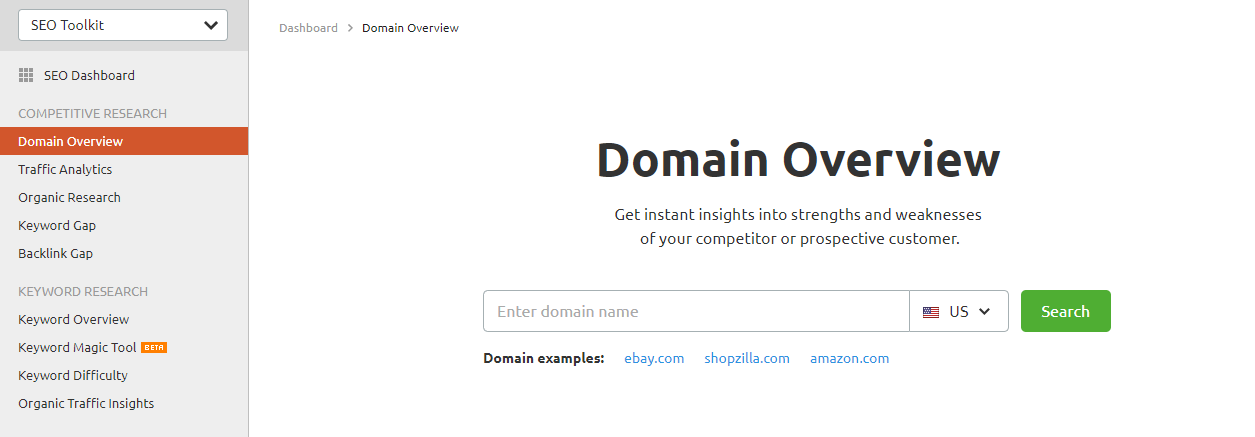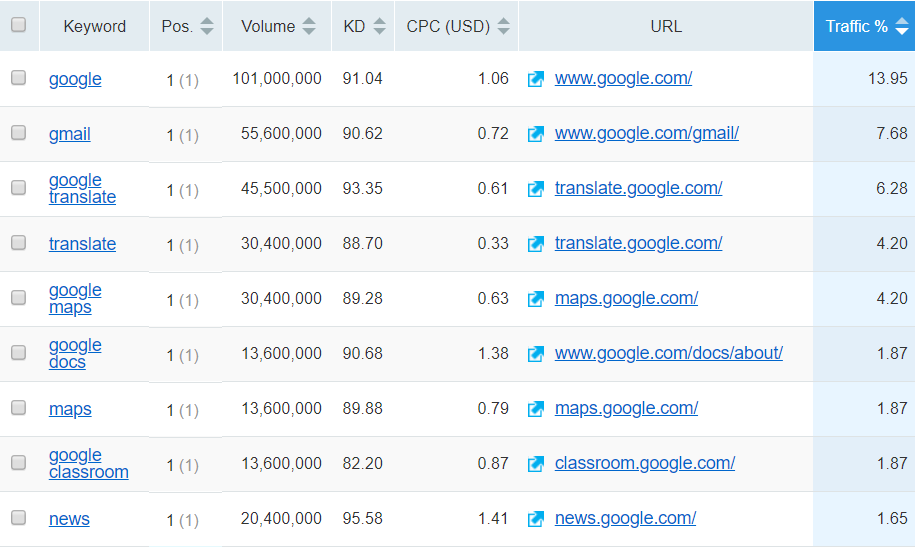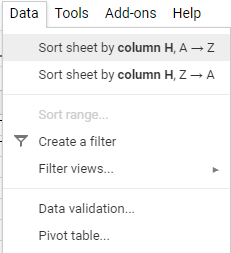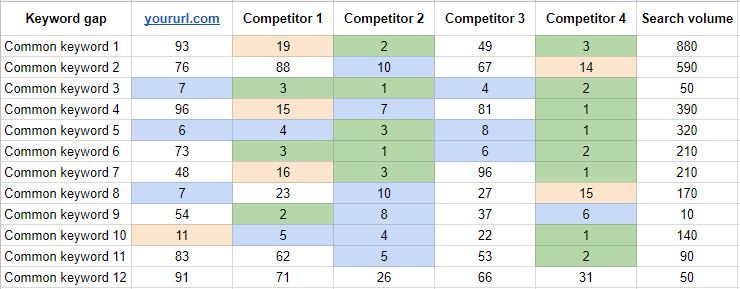If you were a coach preparing for a football game, your strategy would include an analysis of your opponent and its key players. After all, you would not just send your team onto the field blind, not knowing the strengths and weaknesses of your rival team, would you?
The same applies to content marketing and its underlying content strategy. Even though content marketing is competitive by nature, it is not uncommon to find forethought lacking in published content.
As you know, your content has to be unique, meeting the needs of your audience in an entirely different way than your competitors. Clearly, to achieve such an ambitious goal you first need to know what your competitors are doing.
This is where establishing a content benchmark comes into play.
A content benchmark is a document that includes essential information and analysis about your competitors’ content strategies, as well as SEO data about their keywords and organic traffic.
So, going back to the basics, here is how you can create a content benchmark with Semrush in less than an hour.
Content Benchmarks & Competitive SEO Analysis
You know your audience and have honed a customer persona. You have created an exemplary editorial calendar, and the content you produce is well-researched, well-written, and well-optimized.
These are essential steps in producing relevant, quality content. But with no knowledge of what your competitors are doing, it is all for naught. Content marketing has become increasingly competitive. To position well in search, you need to outdo your competitors if you are to outrank them.
And to do that, you need to ask questions like:
Who are the competitors I need to outrank for my main keywords? What keywords are they using that I am not? What types of content are they producing and what works well for them?
A content benchmark gives you the answers to these essential questions. An express version, as described in this post, helps you achieve it in under an hour. Not having time to create one is no longer a valid excuse for not having one.
With a content benchmark, you can do a complete SWOT (strengths, weaknesses, opportunities, threats) competitive analysis:
Understand the main content marketing strengths and weaknesses of your competitors.
Identify threats to your search rankings while immediately capitalizing on opportunities.
Have a reference to what performs well and what does not when generating ideas for content.
It is important to revisit and revise your content benchmark regularly. Consider it a “living document.”
Tools for Creating a Content Benchmark
To create a content benchmark, all you need is two readily accessible tools.
First, a spreadsheet, whether Microsoft Excel or Google Sheets; this will allow you to filter your data by search volume, traffic percentage, or any other relevant metrics for content at a later stage.
And second, Semrush tools.
Yes, there are many other tools you can use for competitive analysis. However, Semrush provides not only a comprehensive overview but also detailed information about your competitors in a matter of minutes — perfect for creating an express content benchmark.
Identify Your Competitors
First things first: you need to know who your direct competitors are, meaning the ones whose rankings will come at the cost of your own.
Let's begin with the Semrush Domain Overview report.
 Screenshot: Semrush Domain Analytics Overview
Screenshot: Semrush Domain Analytics OverviewEnter your domain name, then scroll to the section displaying Main Organic Competitors and click View Full Report.
The Semrush domain analytics tool then generates a list of your main organic competitors based on the number of keywords shared by your domain and theirs.
Besides your direct competitors, it is likely that the list will also include media sites, organizations, forums, etc. It is up to you to decide whether you want to include these sites in your content benchmark.
However, keep in mind that even though these other domains are not your direct competitors, the fact that they rank for a competing keyword means they are search competitors, so you should consider including them when forging your content strategy.
Actions to take:
Depending on the size of your vertical, select between three and ten competitors.
Note them in the first sheet of your Excel or Google Sheets document.
Name this sheet Main Competitors.
The next few steps of your content benchmark will be based on this list of competitors you have chosen.
Analyze Your Competitors’ Keywords
Increasing organic traffic with content marketing and SEO is one of the main objectives of all marketers.
In fact, 61% of marketers say generating traffic is their company’s top marketing challenge, underscoring the value of the data you can pull from the list of your competitors’ keywords and the landing pages for which they rank.
Imagine you had the opportunity to ask your competitors’ marketing managers about their acquisition strategies and the kind of content they are publishing to rank for specific keywords.
Well, we know that is a dream that is unlikely to come true. What is more realistic is getting your hands on information about your competitors’ organic traffic with our keyword and backlink analysis tool.
Suppose Google was your competitor and you wanted to find out the keywords it was using to increase traffic. This is what you would see:

Actions to take:
Go back to the Domain Overview page. Enter the domains of the competitors you have selected in the previous step. You will need to do this one by one.
Under the Top Organic Keywords snippet, click View Full Report.
Export the list. If your competitor has an extremely large volume of traffic, you may want to consider downloading just the first 100 or 500.
After downloading this list, copy the data from the columns Keyword, URL, and Traffic % and paste them in your content benchmark document.
Repeat this for all your competitors. Make sure to separate each competitor into different sheets.
Analyze the Type of Content that Works Best for Your Competitors
As a content marketer, besides the direct data this list generates, there is more information that you can acquire that may interest you. For example, the traffic received by the different types of content your competitors publish.
But this will require a little more manual work and analysis from you.
Knowing the percentage of organic traffic your competitors generate from a particular type of content is, well, pure gold for your content strategy.
Would it not help to know, for example, that one of your competitors was getting most of its organic traffic from its FAQ section? This information could be vital, especially if you don’t have an FAQ section yourself!
Actions to take:
Make sure that you have the three pieces of data obtained from the previous step (Keyword, URL, Traffic %) separated into different columns for each competitor.
Add an extra column to the left of Traffic %. Title it Content Type.
Manually assign content type categories to each URL; this may be home, blog, help section, FAQs, product pages, etc. You decide how detailed you want your categories to be.
This step can be rather tedious. To speed things up, sort the sheet by the column in which you have the URLs; this will group repeat URLs together in consecutive rows so that you can categorize them all in one go.

Once you are done categorizing, simply re-sort the results by Content Type to get an idea of the amount of traffic each type of content is generating for your competitors.
Pro tip: For a closer look, you may add a pivot table. Once you have the new sheet, under Rows, add Content Type and URL. Under Values, add Traffic %; this gives you the exact percentage of organic traffic your competitors’ content is generating based on the categories you defined earlier.
Use Keyword Gap to Discover New Content Opportunities
With the tedious part over, you can now simply collect data to discover new opportunities for your content strategy. Content gap analysis is an easy and useful way to improve strategy and oust competitors from the top spot. But to do this, you need to know where to look.
Thankfully, Semrush’s Keyword Gap tool is pretty magical and can do everything for you.
Previously called Domain vs. Domain, the Keyword Gap feature allows you to select up to five domains and compare common and exclusive keywords.
Discover Common Keywords
Enter the domains of the competitors you want to analyze. You may select up to five at once. Hover over the Venn diagram between the two domains and select Common Keywords in the drop-down menu.

By default, Semrush has set organic keywords as the search, and this will be the most relevant data you need for your content benchmark and SEO. But you also have the option of filtering for other types of keywords such as paid and PLA (Product Listing Ads).
Actions to take:
Export the list of keywords you have in common with your competitors.
Copy and paste the list of common keywords and keywords positions of your competitors into a new sheet in your content benchmark document.
Assign different colors to the cells based on the keyword positions of your competitors. For example, positions 1 to 5 in one color, 6 to 10 in another, etc.

In the example in the above screenshot, green is assigned to the keywords for which your competitor appears in the first three positions; blue for positions from four to 10, and light orange from 11 to 20.
By organizing it this way, it helps you to visualize and pinpoint the keywords for which there is most potential to outrank your competitors.
Discover Exclusive Keywords
As valuable as common keywords are, these are keywords that you already rank for and (perhaps) whose rankings you can improve for.
But what about keywords your competitors are ranking for that you are not?
Another interesting feature the Keyword Gap tool offers is the possibility to look up each of your competitors’ unique keywords.

Actions to take:
Enter your domain and your competitors’ domains. This time, select Unique Keywords in the intersecting drop-down menu. Do this for all your competitors.
Export the list of unique keywords.
Create a new sheet in your content benchmark document with three columns: Keyword, Competitor, and Monthly Search Volume.
Paste the unique keywords of each competitor and their monthly search volumes.
Manually add your competitors’ names to the corresponding keywords.
Pro tip: Use this list as a quick source of inspiration for content creation. When prioritizing, the search volume of each of these keywords draws a pretty clear picture of their potential.
Let Your Competitors Inspire New Content Ideas
At this point, you have collected plenty of data about your competitors' content strategy. All you have to now is analyze them properly to generate new and exciting ideas for your editorial calendar.
It is all about getting inspired by your competitors. Copying content ideas isn't difficult. The trick here will be to give it a new and creative spin — one that sets you apart.
By combining your ideas with the inspiration you get from your competitors, you have the advantage of an original approach that creates new pieces of unique content adapted to your company’s tone, style, and context.
Actions to take:
Create one final sheet in your content benchmark document and call it Content Ideas.
Add headings to five new columns: Content Idea, Main Keyword, Search Volume, Content Type (blog article, landing page, ebook, etc.), and Priority.
Assign priorities to each content idea you were able to come up with, keeping in mind your priorities and available resources.
Based on the priorities you have assigned, add these new ideas to your editorial calendar.
Pro tip: Once you have completed your content benchmark, share the document with all the members of your team. This information is extremely valuable for generating new ideas for email marketing, social media, public relations, etc.
The list of new content ideas is simply a plus. What is important is the new information about your competitors you were able to obtain from the content benchmark.
Now that you are equipped with the information you need to defend your keyword ranking and outperform your competitors, it’s time to go out and do so!
Innovative SEO services
SEO is a patience game; no secret there. We`ll work with you to develop a Search strategy focused on producing increased traffic rankings in as early as 3-months.
A proven Allinclusive. SEO services for measuring, executing, and optimizing for Search Engine success. We say what we do and do what we say.
Our company as Semrush Agency Partner has designed a search engine optimization service that is both ethical and result-driven. We use the latest tools, strategies, and trends to help you move up in the search engines for the right keywords to get noticed by the right audience.
Today, you can schedule a Discovery call with us about your company needs.
Source:





